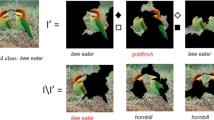Abstract
Cancer prediction models, which deeply impact human lives, must provide explanations for their predictions. We study a simple extension of a cancer mammogram classifier, trained with image-level annotations, to facilitate the built-in generation of prediction explanations. This extension also enables the classifier to learn from local annotations of malignant findings, if such are available. We tested this extended classifier for different percentages of local annotations in the training data. We evaluated the generated explanations by their level of agreement with (i) local annotations of malignant findings, and (ii) perturbation-based explanations, produced by the LIME method, which estimates the effect of each image segment on the classification score. Our results demonstrate an improvement in classification performance and explainability when local annotations are added to the training data. We observe that training with only 20–40% of the local annotations is sufficient to achieve improved performance and explainability comparable to a classifier trained with the entire set of local annotations.
Access this chapter
Tax calculation will be finalised at checkout
Purchases are for personal use only
Similar content being viewed by others
Notes
References
Wu, N., et al.: Deep neural networks improve radiologists’ performance in breast cancer screening. IEEE Trans. Med. Imaging 39, 1184–1194 (2019)
Rodriguez-Ruiz, A., et al.: Stand-alone artificial intelligence for breast cancer detection in mammography: comparison with 101 radiologists. JNCI J. Nat. Cancer Inst. 111, 916–922 (2019)
Akselrod-Ballin, A., et al.: Predicting breast cancer by applying deep learning to linked health records and mammograms. Radiology 292, 331–342 (2019)
Kim, H.-E., et al.: Changes in cancer detection and false-positive recall in mammography using artificial intelligence: a retrospective, multireader study. Lancet Digit. Health 2, e138–e148 (2020)
McKinney, S.M., et al.: International evaluation of an AI system for breast cancer screening. Nature 577, 89–94 (2020)
Oquab, M., Bottou, L., Laptev, I., Sivic, J.: Is object localization for free?-weakly-supervised learning with convolutional neural networks. Presented at the Proceedings of the IEEE Conference on Computer Vision and Pattern Recognition (2015)
Hwang, S., Kim, H.-E.: Self-transfer learning for weakly supervised lesion localization. In: Ourselin, S., Joskowicz, L., Sabuncu, M.R., Unal, G., Wells, W. (eds.) MICCAI 2016. LNCS, vol. 9901, pp. 239–246. Springer, Cham (2016). https://doi.org/10.1007/978-3-319-46723-8_28
Le, T.-L.-T., Thome, N., Bernard, S., Bismuth, V., Patoureaux, F.: Multitask classification and segmentation for cancer diagnosis in mammography. arXiv preprint arXiv:1909.05397 (2019)
Gao, F., Yoon, H., Wu, T., Chu, X.: A feature transfer enabled multi-task deep learning model on medical imaging. Expert Syst. Appl. 143, 112957 (2020). https://doi.org/10.1016/j.eswa.2019.112957
Bakalo, R., Goldberger, J., Ben-Ari, R.: A dual branch deep neural network for classification and detection in mammograms. arXiv preprint arXiv:1904.12589 (2019)
Bilen, H., Vedaldi, A.: Weakly supervised deep detection networks. Presented at the Proceedings of the IEEE Conference on Computer Vision and Pattern Recognition (2016)
Guidotti, R., Monreale, A., Ruggieri, S., Turini, F., Giannotti, F., Pedreschi, D.: A survey of methods for explaining black box models. ACM Comput. Surv. 51, 93:1–93:42 (2018). https://doi.org/10.1145/3236009
Samek, W., Binder, A., Montavon, G., Lapuschkin, S., Müller, K.-R.: Evaluating the visualization of what a deep neural network has learned. IEEE Trans. Neural Netw. Learn. Syst. 28, 2660–2673 (2017). https://doi.org/10.1109/TNNLS.2016.2599820
Adebayo, J., Gilmer, J., Muelly, M., Goodfellow, I., Hardt, M., Kim, B.: Sanity checks for saliency maps. In: Bengio, S., Wallach, H., Larochelle, H., Grauman, K., Cesa-Bianchi, N., Garnett, R. (eds.) Advances in Neural Information Processing Systems, vol. 31, pp. 9505–9515. Curran Associates, Inc. (2018)
Ribeiro, M.T., Singh, S., Guestrin, C.: “Why should i trust you?”: explaining the predictions of any classifier. In: Proceedings of the 22nd ACM SIGKDD International Conference on Knowledge Discovery and Data Mining, pp. 1135–1144. Association for Computing Machinery, New York (2016). https://doi.org/10.1145/2939672.2939778
Lundberg, S.M., Lee, S.-I.: A unified approach to interpreting model predictions. In: Guyon, I., et al. (eds.) Advances in Neural Information Processing Systems, vol. 30, pp. 4765–4774. Curran Associates, Inc. (2017)
He, K., Zhang, X., Ren, S., Sun, J.: Deep residual learning for image recognition. Presented at the Proceedings of the IEEE Conference on Computer Vision and Pattern Recognition (2016)
Szegedy, C., Ioffe, S., Vanhoucke, V., Alemi, A.A.: Inception-v4, Inception-ResNet and the impact of residual connections on learning. Presented at the Thirty-First AAAI Conference on Artificial Intelligence (2017)
Simonyan, K., Zisserman, A.: Very deep convolutional networks for large-scale image recognition. arXiv preprint arXiv:1409.1556 (2014)
Ribli, D., Horváth, A., Unger, Z., Pollner, P., Csabai, I.: Detecting and classifying lesions in mammograms with deep learning. Sci. Rep. 8, 1–7 (2018)
Author information
Authors and Affiliations
Corresponding author
Editor information
Editors and Affiliations
Rights and permissions
Copyright information
© 2020 Springer Nature Switzerland AG
About this paper
Cite this paper
Ness, L., Barkan, E., Ozery-Flato, M. (2020). Improving the Performance and Explainability of Mammogram Classifiers with Local Annotations. In: Cardoso, J., et al. Interpretable and Annotation-Efficient Learning for Medical Image Computing. IMIMIC MIL3ID LABELS 2020 2020 2020. Lecture Notes in Computer Science(), vol 12446. Springer, Cham. https://doi.org/10.1007/978-3-030-61166-8_4
Download citation
DOI: https://doi.org/10.1007/978-3-030-61166-8_4
Published:
Publisher Name: Springer, Cham
Print ISBN: 978-3-030-61165-1
Online ISBN: 978-3-030-61166-8
eBook Packages: Computer ScienceComputer Science (R0)





